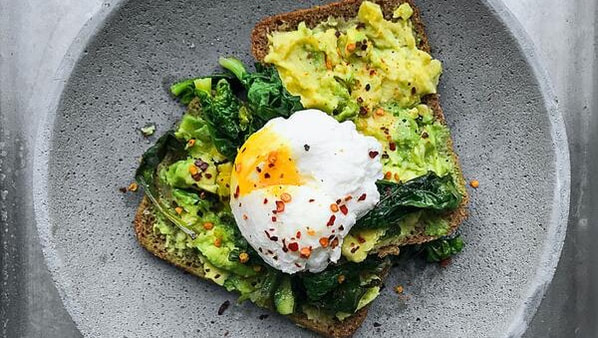Stay committed to your decisions, but stay flexible in your approach. Spoiler alert: Yes, it’s possible! (Gasp.) Humans were changing their body size long before calories and calorie-tracking apps existed. Tracking calories and macros can be a very successful approach to losing fat, gaining muscle, or maintaining your weight. In fact, it’s the method I’ve had the greatest success with in my own bodybuilding journey, and I employ it with many clients. However, it isn’t for everyone. You can never track calories or macros, and still get great results. So, if you’ve tried it and it just isn’t for you, why not have a crack at one of the three fat loss methods in this article? Fair warning: Not a single one of them involves cutting out entire food groups, your favourite treats, or any joy from your life! #1. The Athlete’s Plate Method
The Athlete’s Plate Method is inspired by the Athlete’s Plate nutrition model, designed to help athletes understand how to adjust their meals based on the intensity of their training at any given time. This method includes three meals and two optional snacks per day. Each meal will fit into one plate or bowl, and each snack will be the size of your palm. This is what one meal looks like on the plate:
The snacks can be anything you want, as long as they’re only as big as your palm: a biscuit, a small scoop of ice-cream, a couple of small pancakes, an apple, a handful of berries or nuts… Even a small glass of wine! If you’re lifting weights regularly, an ideal snack could be a protein source, like a small pot of Greek yogurt, as protein will help you build muscle mass alongside your training. You can start with three meals and two snacks per day. At the same time, you’ll monitor your weight, the way your clothes fit, your pictures, and your measurements. Compare these data on a weekly basis to gauge whether you need any changes:
As a final note, if you choose to have a meal out, you can pick one of these strategies:
#2. The Hand-Sized Portion Method The Hand-Sized Portion Method requires you to track your food. However, instead of weighing each morsel and recording the calories, you’ll use your hand to gauge the quantity of food you’re eating. Here are the three steps you need to succeed with this approach: Step 1: First, spend at least two weeks recording what you’re eating right now. You can either make up your own hand-sized portion guide, or use this:
As a side note, alcohol is a separate nutrient, but, with this method, you’ll count it as a fat source. Step 2: Logging your current food this way will give you an insight into how many portions of each nutrient source (protein, carbohydrates, fats) you’re eating at the moment whilst maintaining your weight. These are your baseline, or maintenance portions. To accurately quantify your maintenance portions, add up all the portions of a certain nutrient eaten in a week, then divide by the days of the week to get your daily average. For example, if you had five portions of carbs on three days, then six portions on four days, that’s 5 + 5 + 5 + 6 + 6 + 6 + 6 = 39, which divided by 7 is 5.5 portions of carbs per day on average. Step 3: Going forward, you can tweak your food log to achieve fat loss in the following ways:
Stick to your new self-made meal plan for at least a month. At the same time, assess scale weight, pictures, the fit of your clothes, and body measurements on a weekly basis. When you hit a plateau for two to four weeks, consider making a further 5 to 10% reduction to your portions of carbs or fat, then repeat the assessment process. #3. The Best of Both Worlds Method With this method, you’ll use calorie-counting only for the diet setup and as a way to troubleshoot plateaus, then you’ll rely on the resulting food log the rest of the time, with no need to continue tracking. It works like this:
When you get to Step 5, you don’t have to eat the exact same meals every single day. What you can do is replace a certain food with another source of the same nutrient with a similar amount of calories. For example, you can replace chicken breast (about 100 to 120 calories per 100gr serving) with canned tuna (about 90 to 110 calories per 100gr); pasta with rice (both about 350 to 360 calories per 100gr); or red peppers with courgettes (both around 20 to 30 calories per 100gr). If you choose an alternative with roughly the same amount of calories and the same macronutrients (carbs, protein, or fat), rest assured that you’ll see very similar fat loss results. You can have progress without getting bored of your diet! Final Thoughts Calories will influence whether you lose or gain weight… but you don’t need to track them to lose fat! Now you have three methods to choose from to achieve your fat loss goal with minimal or zero calorie-tracking. Hit me up in a comment to let me know which one you choose!
0 Comments
Your comment will be posted after it is approved.
Leave a Reply. |
Nikias TomasielloWelcome to my blog. I’m an online fitness coach with a passion for bodybuilding, fantasy, and bread. Want to work with me? Check out my services!Archives
May 2024
Tags
All
|
Follow me on social media |
Get in touch |
© 2018-2023 Veronica Tomasiello, known as Nikias Tomasiello – All rights reserved


 RSS Feed
RSS Feed